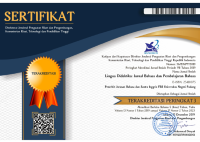Gender Stereotyping in Brown Watson’s Picture Books (2012)
 ),
), (1) Universitas Pamulang
(2) Universitas Pamulang
 Corresponding Author
Corresponding Author
Copyright (c) 2021 Lingua Didaktika: Jurnal Bahasa dan Pembelajaran Bahasa
DOI : https://doi.org/10.24036/ld.v15i2.112238
Full Text:
 Language : en
Language : en
Abstract
This paper discusses gender stereotyping represented in two selected picture books, My Little Book of Stories for Girls and My Little Book of Stories for Boys by Brown Watson (2012). The verbal and visual texts were examined to reveal the symbolical meanings of gender stereotyping which then argued by using Judith Butler’s gender performativity. The analysis results in a clear distinction between the performances of female and male characters. By separating female and male characters into completely different categorizations through their appearances, traits, and behavior, the first picture book represents feminine gender stereotypes that females are princesses who stay in the palace while the second represents masculine gender stereotypes that males are outdoor working individuals.
Keywords
References
Afifah, A. R. (2018). Sexism in children’s literature (the tale of peter rabbit and the tale of jemima puddle-duck) by beatrix potter. (Undergraduate’s thesis). Universitas Islam Negeri Maulana Malik Ibrahim, Malang.
Ary. D., Jacobs, L.C., & Sorensen, C. (2010). Introduction to research in education (8th ed.). Wardsworth, Ohio: Cengage Learning.
Blackstone, A. M. (2003). Gender Roles and Society. Human ecology: An encyclopedia of children, families, communities, and environment. 335-338.
Butler, J. (1999). Gender trouble: Feminism and subversion of identity. New York: Routledge.
Frassanito, P., & Pettorini, B. (2008). Pink and blue: The color of gender. Childs nervous system.
Kuon, T., & Weimar, H. (2009). Wake up sleeping beauty: Strong heroines for today’s world. Advancing women in leadership journal, 29.
Levi-Strauss, C. (1995). The structural study of myth. The journal of american folklore, 68, 428-444.
Nope, F. T. S. (2016). Aladdin character in disney’s aladdin movie as a reconstruction toward traditional men role in arabic society. (Undergraduate’s thesis). Universitas Brawijaya, Malang.
Nurwahyuni, E. E. (2015). Social construction and impact on individual quality a portrait of gender role in the glass menagerie play. (Undergraduate’s thesis). Universitas Negeri Semarang.
Peterson, S. & Lach, M. (1990). Gender stereotypes in children’s books: Their prevelance and influence on cognitive and affective development. Gender and education, 2(2).
Prentice, D. A., & Carranza, E. (2002). What women should be, shouldn’t be, are allowed to be, and don’t have to be: The contents of prescriptive gender stereotypes. Psychology of women quarterly, 26(4).
Turner-Bowker, D. M. (1996). Gender stereotyped descriptors in children’s picture books: Does “curious Jane” exist in the literature? Sex roles: a journal of research, 35(7-8).
Watson, B. (2012). My little book of stories for boys. England: Brown Watson.
Watson, B. (2012). My little book of stories for girls. England: Brown Watson.
 Article Metrics
Article Metrics
 Abstract Views : 1156 times
Abstract Views : 1156 times
 PDF Downloaded : 656 times
PDF Downloaded : 656 times
Refbacks
- There are currently no refbacks.
Copyright (c) 2021 Lingua Didaktika: Jurnal Bahasa dan Pembelajaran Bahasa

This work is licensed under a Creative Commons Attribution-NonCommercial 4.0 International License.









